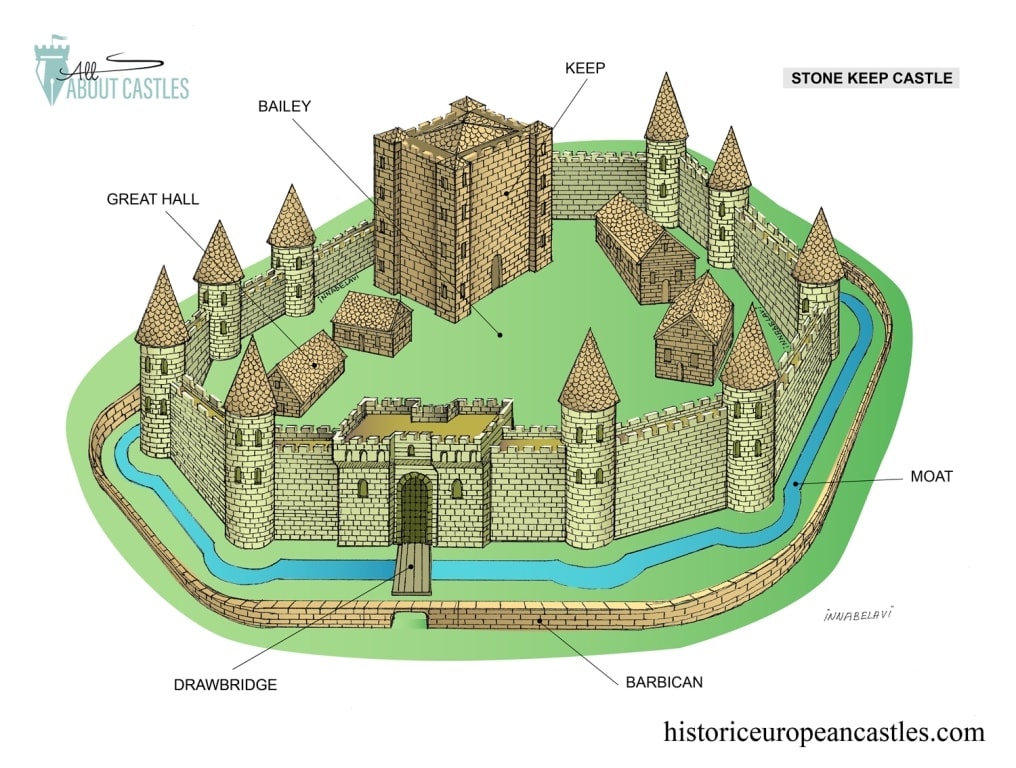
Castle interior Dover castle, Castle, Castle designs
A plan of the buildings and layout of Edinburgh Castle, Scotland. Although occupied since the Bronze Age and site of a medieval castle from the 11th century, most of the structures today date from around 1500 with additions and modifications made over subsequent centuries.

Castle gatehouse Qfiles Encyclopedia Castle layout, Castle plans, Fantasy castle
Bodiam Castle East Sussex England UK. Medieval castles are architectural structures that were prevalent during the Middle Ages in Europe, spanning roughly from the 5th to the 15th century.. Upon passing through the main gate, you enter the castle's intricate layout, often consisting of two walls. The inner wall acts as the castle's.

Kid Friendly Graphic Design of a Medieval Castle Hotham Digons
Medieval Castles were constructed in three different architectural phases, depending on the primary purpose of the castle and the necessity for a castle to be fortified as a stronghold against invaders. The four basic architectural styles-pre-Romanesque (motte-and-bailey), Romanesque ( Norman castles ), and Gothic-were the basis of castles.

Castle layout, Medieval castle layout, Castle plans
Medieval Castle s were built from the 11th century CE for rulers to demonstrate their wealth and power to the local populace, to provide a place of defence and safe retreat in the case of attack, defend strategically important sites like river crossings, passages through hills, mountains, and frontiers, and as a place of residence.

Find hd free Castle Floor Plans Or How A Castle Is Designed With Medieval Castle Keep Floor
Castle Layout: Spaces for Living and Sleeping Great Hall If you read medieval literature, you've probably seen mentions of the Great Hall. Medieval writers often waxed poetic about the great hall, associating it with warmth and celebration. Great Hall of Edinburgh Castle

ss6shms [licensed for use only] / Castle Middle Ages Medieval castle layout
A cutaway drawing of a drawbridge mechanism. A tower house castle with an extra tower added to create the L shape. Castle plan rendered in AutoCAD with colored lights added. A mansion type castle plan with large great room in the center. A full size castle tower that you can live or play in. $750k Two story castle hall. Castle hall with end tower.

Diagram Of A Castle diagramwirings
This medieval castle layout diagram is adapted by from an original by HCHC2009 licence CC-BY-SA-3.0; via Wikimedia Commons. The Keep The Keep was traditionally the heart of any Medieval castle layout. It was usually the tallest and strongest tower, situated at the heart of the fortifications.

9 Different Types of Castles Built Throughout History
The design and layout of a medieval castle were a testament to the strategic thinking of the time. Fortifications such as the Keep were designed to resist invasion and protect the lord and his family. The armory housed weapons that were essential to castle defense, while the gardens provided beauty and sustenance amidst the stone walls..

Medieval Castle Layout The Different Rooms and Areas of a Typical Castle Exploring Castles
Typically, a great hall would have a rectangular layout, with a floorplan between one and a half to three times longer than it was wide. The room would also have a high ceiling as well as a raised area or 'dais' at the high end of the hall, where the lord, his household, and his guests would dine, in clear view of the rest of the hall.

Castle layouts Google Search World Building Pinterest Castles, Medieval and Medieval times
1. Medieval Castle The medieval time period was from the 5th century to 15th century. During that time many castles were built throughout Europe. While there are many layout and design variations, many were built with a somewhat similar layout as shown above. 2. Motte-and-Bailey
This 22 Blueprints Of A Castle Are The Coolest Ideas You Have Ever Seen House Plans
A semicircular projecting part of a building, usually vaulted. Arcade, Rochester Castle Keep Mball93 (CC BY-SA) Arcade An area of columned arches. Arrow Loop Jebulon (Public Domain) Arrow Loop The narrow window of a wall or tower through which arrows and crossbow bolts could be fired.

concentric castle layout Google Search Medieval castle layout, Castle layout, Castle floor plan
The word castle is sometimes applied to prehistoric earthworks, such as Maiden Castle in England, and is also applied, in various linguistic forms (e.g., château, castello, and Burg ), to princely mansions or country seats. château of the dukes of Anjou Château of the dukes of Anjou, Saumur, France. History of Hohenschwangau Castle

Castle diagram Castle layout, Medieval castle layout, Medieval castle
Rooms in a Medieval Castle. Rooms in a medieval are largely recognisable by their modern counterparts in more modest homes. Kitchens are still kitchens. So are pantries and larders. So are cellars. Bed chambers are now known as bedrooms. Latrines have become lavatories and bathrooms. Halls have morphed into entrance halls and dining rooms have.

Caernarfon castle Ancient and medieval architecture Medieval castle layout, Medieval
Medieval Castle Layouts To differentiate properly between the medieval castle and keep, here's a look at the buildings that were housed inside the usual Medieval castle complex: The Gatehouse and Moat The medieval gatehouse was one of the most important parts of the castle.

Conwy castle plan completed in 1287 Castle layout, Castle plans, Castle floor plan
"The layout and design of a medieval castle were based on its intended function and the latest defensive strategies, but also on the available technology, the skill of the builders, and the geography of the site." Dr. John Goodall, Architectural Editor of Country Life magazine and author of "The English Castle: 1066-1650".

Harlech Castle layout Castles of Wales Pinterest Castles, Medieval Castle and Layout
The first castles, built in the Early Middle Ages (early Medieval period), were 'earthworks' - mounds of earth primarily built for defence, as enemies struggled to climb them. During the 1000s, the Normans developed these into Motte and Bailey castle designs.